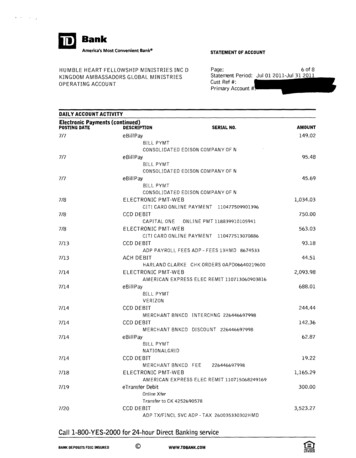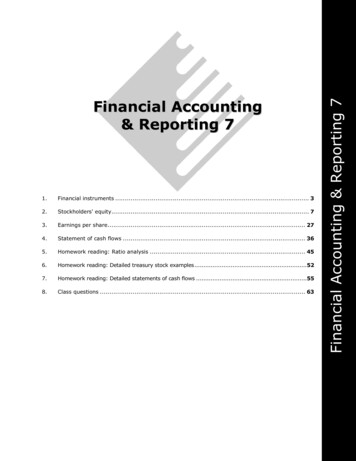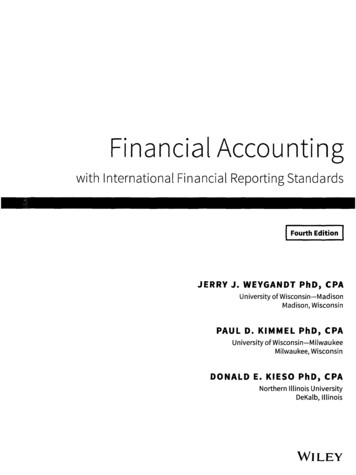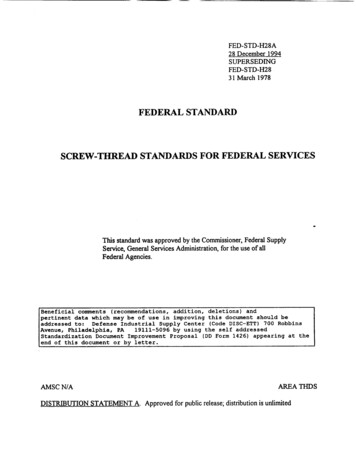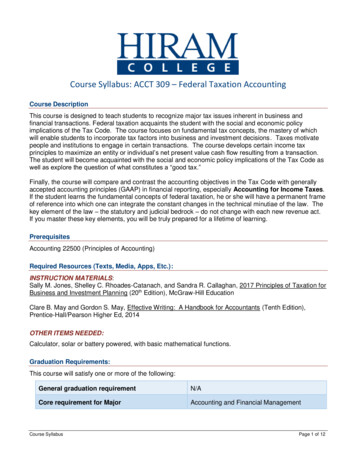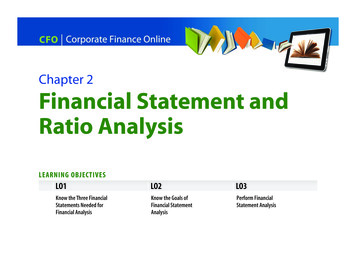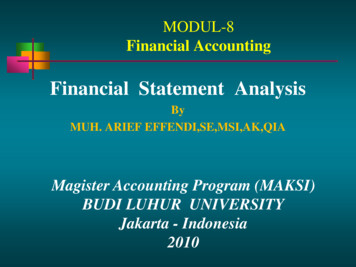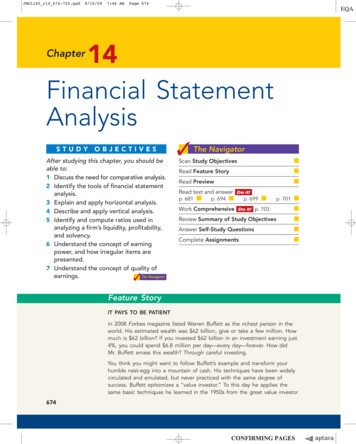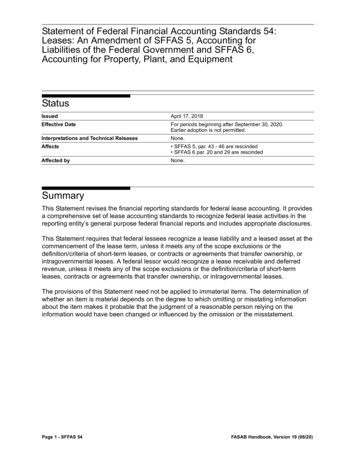
Transcription
Statement of Federal Financial Accounting Standards 54:Leases: An Amendment of SFFAS 5, Accounting forLiabilities of the Federal Government and SFFAS 6,Accounting for Property, Plant, and EquipmentStatusIssuedApril 17, 2018Effective DateFor periods beginning after September 30, 2020.Earlier adoption is not permitted.Interpretations and Technical ReleasesNone.Affects SFFAS 5, par. 43 - 46 are rescinded SFFAS 6 par. 20 and 29 are rescindedAffected byNone.SummaryThis Statement revises the financial reporting standards for federal lease accounting. It providesa comprehensive set of lease accounting standards to recognize federal lease activities in thereporting entity’s general purpose federal financial reports and includes appropriate disclosures.This Statement requires that federal lessees recognize a lease liability and a leased asset at thecommencement of the lease term, unless it meets any of the scope exclusions or thedefinition/criteria of short-term leases, or contracts or agreements that transfer ownership, orintragovernmental leases. A federal lessor would recognize a lease receivable and deferredrevenue, unless it meets any of the scope exclusions or the definition/criteria of short-termleases, contracts or agreements that transfer ownership, or intragovernmental leases.The provisions of this Statement need not be applied to immaterial items. The determination ofwhether an item is material depends on the degree to which omitting or misstating informationabout the item makes it probable that the judgment of a reasonable person relying on theinformation would have been changed or influenced by the omission or the misstatement.Page 1 - SFFAS 54FASAB Handbook, Version 19 (06/20)
SFFAS 54Table of ContentsSummary1Standards3Scope3Definition4Lease Term5Short-Term Leases8Contracts or Agreements that Transfer Ownership9Intragovernmental Leases9Lessee Recognition, Measurement, and Disclosures for Leases Other than Short-TermLeases, Contracts or Agreements that Transfer Ownership, and Intragovernmental Leases11Lessor Recognition, Measurement, and Disclosures for Leases Other than Short-TermLeases, Contracts or Agreements that Transfer Ownership, and Intragovernmenal Leases15Financial Report of the U.S. Government Disclosures19Lease Incentives and Lease Concessions19Contracts or Agreements with Multiple Components20Contract or Agreement Combinations21Lease Terminations and Modifications21Subleases23Sale-Leaseback Transactions23Lease-Leaseback Transactions24Amendments to SFFAS 5, Accounting for Liabilities of the Federal Government, and SFFAS6, Accounting for Property, Plant, and Equipment24Implementation27Effective Date28Appendix A: Basis for Conclusions29Appendix B: Abbreviations41Page 2 - SFFAS 54FASAB Handbook, Version 19 (06/20)
SFFAS 54StandardsScope1.This Statement applies to federal entities that present general purpose federal financialreports, including the consolidated financial report of the U.S. Government (CFR), inconformance with generally accepted accounting principles, as defined by paragraphs 5through 8 of Statement of Federal Financial Accounting Standards (SFFAS) 34, TheHierarchy of Generally Accepted Accounting Principles, Including the Application ofStandards Issued by the Financial Accounting Standards Board.2.For purposes of applying this Statement, a lease1 is defined as a contract or agreementwhereby one entity (lessor) conveys the right to control the use of property, plant, andequipment (PP&E)2 (the underlying asset) to another entity (lessee) for a period of time asspecified in the contract or agreement in exchange for consideration. To qualify as a lease,the underlying asset typically should be identified by being explicitly specified in a contractor agreement. However, an asset also can be identified by being implicitly specified at thetime that the asset is made available for use by the lessee. Leases include contracts oragreements that, although not explicitly identified as leases, meet the definition of a lease.3.To determine whether a contract or agreement conveys the right to control the use of theunderlying asset, a federal entity should assess whether the contract or agreement givesthe lessee both of the following:4.1a.The right to obtain economic benefits or services from use of the underlying asset asspecified in the contract or agreementb.The right to control access to the economic benefits or services of the underlying assetas specified in the contract or agreementThe lease definition excludes contracts or agreements for services, except those contractsor agreements that contain both a lease component and a service component (par.73). Aservice contract is a contract that directly engages the time and effort of a contractor whoseprimary purpose is to perform an identifiable task rather than to provide a tangible asset.Terms defined in the Glossary are shown in bold-face the first time they appear.2SFFAS 6, Accounting for Property, Plant, and Equipment.Page 3 - SFFAS 54FASAB Handbook, Version 19 (06/20)
SFFAS 545.This Statement does not apply toa.leases of assets under construction orb.leases (licenses) of internal use software (SFFAS 10, Accounting for Internal UseSoftware, as amended).DefinitionsDefinitions in paragraphs 6 through 13 are presented within the standards becausethey are new terms intended to have a specific meaning when applying the standards.6.Lease – A lease is defined as a contract or agreement whereby one entity (lessor) conveysthe right to control the use of PP&E (the underlying asset) to another entity (lessee) for aperiod of time as specified in the contract or agreement in exchange for consideration.7.Short-Term Lease – A short-term lease is a lease with a lease term (as defined in par. 1421) of 24 months or less.8.Intragovernmental Lease – An intragovernmental lease is a contract or agreementoccurring within a consolidation entity or between two or more consolidation entities asdefined in SFFAS 47, Reporting Entity3 whereby one entity (lessor) conveys the right tocontrol the use of PP&E (the underlying asset) to another entity (lessee) for a period of timeas specified in the contract or agreement in exchange for consideration.9.Lease Incentives – Lease incentives include lessor payments made to or on behalf of thelessee to entice the lessee to sign a lease. Lease incentives may include up-front cashpayments to the lessee; for example, moving costs, termination fees to the lessee’s priorlessor, or the lessor’s assumption of the lessee’s lease obligation under a different leasewith another lessor.10. Lease Concessions – Lease concessions are rent discounts made by the lessor to enticethe lessee to sign a lease. Lease concessions include rent holidays/free rent periods,reduced rents, or commission credits.3SFFAS 47, Reporting Entity, par. 38–42.Page 4 - SFFAS 54FASAB Handbook, Version 19 (06/20)
SFFAS 5411. Leasehold Improvements – Leasehold improvements are additions, alterations,remodeling, renovations, or other changes to a leased property that either extend the usefullife of the existing property or enlarge or improve its capacity and are paid for (financed) bythe lessee.12. Lessor Improvements – Lessor improvements are additions, alterations, remodeling,renovations, or other changes to a leased property that either extend the useful life of theexisting property or enlarge or improve its capacity and are paid for (financed) by the lessorrather than by the lessee.13. Initial Direct Lease Costs – Initial direct lease costs are costs that are directly attributableto negotiating and arranging a lease or portfolio of leases that would not have been incurredwithout entering into the lease.Lease Term14. The lease term is the noncancelable period plus certain periods subject to options to extendor terminate the lease. The noncancelable period is the shorter ofa.the period identified in the lease contract or agreement that precedes any option toextend the lease orb.the period identified in the lease contract or agreement that precedes the first option toterminate the lease.15. The lessee’s lease term includes the noncancelable period and the following periods, ifapplicable:aThose periods specified in the lease contract or agreement that relate to a lessee’soption to extend the lease if it is probable, based on all relevant factors, that the lesseewill exercise that optionb.Those periods specified in the lease contract or agreement that follow a lessee’s optionto terminate the lease (up until the point in time when there is another option or, if none,the end of the lease) if it is probable, based on all relevant factors, that the lessee willnot exercise that optionc.Those periods specified in the lease contract or agreement that relate to a lessor’soption to extend the lease if there is significant evidence, based on all relevant factors,that the lessor will exercise that optionPage 5 - SFFAS 54FASAB Handbook, Version 19 (06/20)
SFFAS 54d.Those periods specified in the lease contract or agreement that follow a lessor’s optionto terminate the lease (up until the point in time when there is another option or, if none,the end of the lease) if there is significant evidence, based on all relevant factors, thatthe lessor will not exercise that option16. The options should be considered in chronological order. If a determination is made that anadditional period will not be added to the lease term for an option based on the likelihoodcriteria above, subsequent options would not be considered. For example, if the lesseedetermined that it was not probable that a lessee option to extend would be exercised; anysubsequent option periods would not be evaluated.17. The lessor’s lease term includes the noncancelable period and the following periods, ifapplicable:a.Those periods specified in the lease contract or agreement that relate to a lessor’soption to extend the lease if it is probable, based on all relevant factors, that the lessorwill exercise that optionb.Those periods specified in the lease contract or agreement that follow a lessor’s optionto terminate the lease (up until the point in time when there is another option or, if none,the end of the lease) if it is probable, based on all relevant factors, that the lessor willnot exercise that optionc.Those periods specified in the lease contract or agreement that relate to a lessee’soption to extend the lease if there is significant evidence, based on all relevant factors,that the lessee will exercise that optiond.Those periods specified in the lease contract or agreement that follows a lessee’soption to terminate the lease (up until the point in time when there is another option or,if none, the end of the lease) if there is significant evidence, based on all relevantfactors, that the lessee will not exercise that option18. The options should be considered in chronological order. If a determination is made that anadditional period will not be added to the lease term for an option based on the likelihoodcriteria above, subsequent options would not be considered. For example, if the lessordetermined that it was not probable that a lessor option to extend would be exercised; anysubsequent option periods would not be evaluated.19. In determining the lease term for both the lessee and lessor, the following specific provisionsshould be applied:Page 6 - SFFAS 54FASAB Handbook, Version 19 (06/20)
SFFAS 54a.Periods for which both the lessee and lessor (1) have an option to terminate the leasewithout permission from the other party or (2) have to agree to extend are cancelableperiods and are excluded from the lease term. For example, month-to-month leaseholdovers, also referred to as rolling lease extensions, or any lease that continues intoa holdover period until a new contract or agreement is signed would be consideredcancelable if both the lessee and the lessor have an option to terminate. Therefore,either could cancel the lease at any time. These holdover periods are cancelableperiods and should be excluded from the lease term.4b.If the lease provisions allow for the termination of a lease due to (a) the purchase of theunderlying asset, (b) the payment of all sums due, or (c) the default on payments, theseprovisions are not considered options to terminate.c.An availability of funds or cancellation clause allows federal lessees to cancel a leaseagreement, typically on an annual basis, if funds for the lease payments are notappropriated. This type of clause should affect the lease term only when it is probablethat the clause will be exercised.20. At the commencement of a lease term, lessors and lessees should assess all factorsrelevant to the likelihood that the lessee will exercise options identified in paragraph 15-19,whether these factors are contract or agreement based, underlying asset based, marketbased, or federal specific. The assessment often will require the consideration of acombination of these interrelated factors. Examples of factors to consider include, but arenot limited to, the following:a.A significant economic incentive, such as contractual or agreement terms andconditions for the optional periods that are favorable compared with current marketratesb.A significant economic disincentive, such as costs to terminate the lease and sign anew lease (for example, negotiation costs, relocation costs, abandonment of significantleasehold improvements, costs of identifying another suitable underlying asset, costsassociated with returning the underlying asset in a contractually specified condition orto a contractually specified location, or a substantial cancellation penalty)c.The history of exercising options to extend or terminate4SFFAS 1, Accounting for Selected Assets and Liabilities, applies to any related accounts payable or accountsreceivable amounts.Page 7 - SFFAS 54FASAB Handbook, Version 19 (06/20)
SFFAS 54d.The extent to which the asset underlying the lease is mission critical to the federalentity
Leasehold Improvements – Leasehold improvements are additions, alterations, remodeling, renovations, or other changes to a l eased property that either extend the useful life of the existing property or enlarge or improve its capacity and are paid for (financed) by the lessee. 12.




